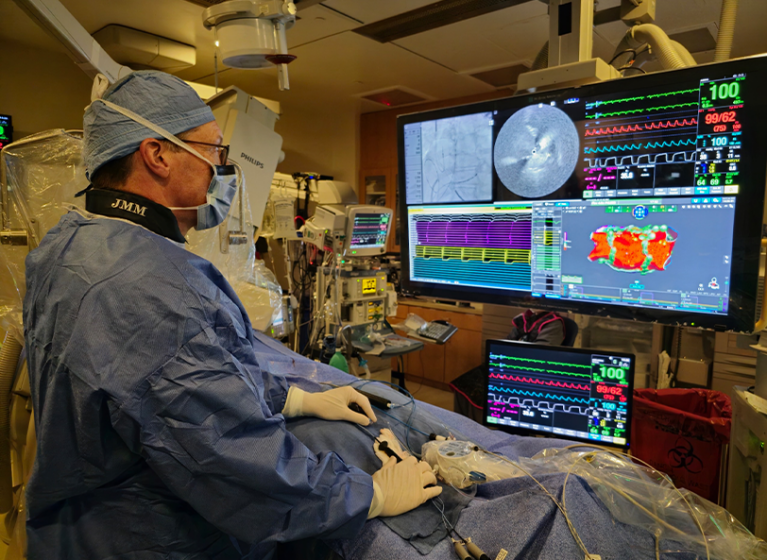
When medications and lifestyle changes don’t improve atrial fibrillation symptoms, the next step is usually an ablation procedure. But, using heat or cold for ablation has an inherent risk of damage to surrounding tissues. That means a need for additional monitoring during the procedure and a potential impact on recovery times and outcomes.
But with pulsed field ablation (PFA), approved by the FDA at the end of 2023, there isn't the same risk of damage to surrounding tissues. That means ablations with PFA can be safer and just as effective as those done with older methods. And with that comes a shorter recovery time and better outcomes.
"Pulse field ablation ablates tissue without significantly affecting tissue temperature, which is key because heating or cooling the cardiac tissue risks damaging adjacent structures. PFA is selective and safer,” notes Mike Mangrum, MD, an electrophysiologist and ablation expert at UVA Health.
What Is Pulsed Field Ablation?
"Unlike traditional ablation, which requires heating or freezing tissue, PFA uses high-frequency electrical pulses,” explains Mangrum. “The energy field created by PFA catheters renders heart cells non-functional without causing heat damage, making it a revolutionary approach compared to traditional methods."
Pulsed field ablation uses extremely quick bursts of electrical energy (at the level of microseconds). The electrical field causes holes to form in the cell membranes of the tissues being ablated. Otherwise, the procedure is like other catheter-based ablation procedures: a catheter is threaded up into the heart to deliver energy that alters heart tissue.
With PFA, the electrical fields target only the cardiac cells. This precision makes it much safer because it avoids damaging nearby structures like the esophagus, pulmonary veins, and nerves. Additionally, we use advanced tools, like both non-invasive mapping vest and intracardiac mapping that tracks the heart’s electrical activity, to guide the procedure. This ensures the electrical pulses are delivered exactly where they’re needed.
How Does PFA Benefit Patients?
PFA offers many advantages over traditional ablation techniques.
Shorter Procedures
Traditional methods can take several seconds to several minutes to treat each area, and many areas are targeted. With PFA, the energy bursts are much shorter. This means a shorter procedure and less time under anesthesia.
"PFA has been found to reduce procedure times compared to radiofrequency ablation, improving efficiency for both doctors and patients," Mangrum says.
Safer for Surrounding Tissues
Because PFA doesn’t use heat or freezing, there isn’t a risk of injury to the esophagus, nerves, or other surrounding structures.
Better Recovery
PFA causes less inflammation and discomfort than other types of ablation. Mangrum says, "Patients undergoing PFA typically recover quicker, often going home the same day with less discomfort, such as chest discomfort due to inflammation sometimes experienced with heating-based ablation methods."
Durable Results
Early studies show PFA is as effective as traditional methods, and in some cases, it may even offer better long-term results.
A Leader in Afib Treatment
UVA Health has been a leader in afib care for decades, pioneering new technologies and participating in early clinical trials. Says Mangrum, “UVA Health has been involved in catheter-based ablation for afib longer than almost any other place in the country, contributing to pivotal advancements since the 1990s."
Over the years, UVA health researchers have led or participated in many major clinical trials exploring the effectiveness of catheter-based procedures for arrhythmia. "We have significant experience with PFA and were part of key clinical trials, including PULSED AF and ADVENT, which selected top sites for participation," says Mangrum. In 2004, UVA Health created its afib Center to focus on both clinical care and groundbreaking research.
And we remain at forefront of adopting and expanding access to new approaches to afib treatment. Now, UVA Health is one of the first centers to adopt the second-generation PFA systems, which promise even better outcomes for patients. "We’ve been offering PFA to patients since its FDA approval, and we’re committed to staying ahead by providing access to the latest systems as they become available," Mangrum notes.
Who Is PFA For?
PFA works for both paroxysmal AF and persistent AF. It's recommended for patients whose afib symptoms don’t improve with medications.
However, it may not be suitable for all patients. Patients with afib continuously for many years may not be good candidates, as the heart tissue often changes over time, making treatment less effective.
A Safer Option for Afib Patients
Pulsed field ablation offers a better experience for afib patients. Thanks to its nonthermal approach, most patients recover quickly and can avoid complications found with other approaches.
And, at UVA Health, patients benefit from access to the latest cutting-edge technologies and decades of experience treating arrhythmias.